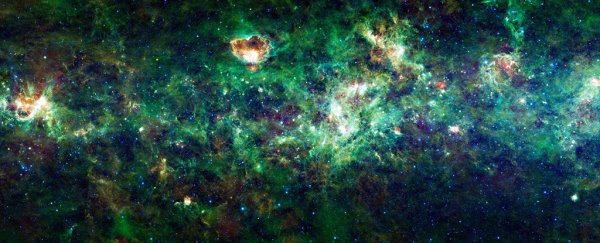Astronomers have now discovered plenty of exoplanets – planets outside our Solar System orbiting suns like our own – but the hunt for smaller exomoons around these planets goes on. Now astronomers think they might have found the very first.
The potential exomoon has been revealed thanks to the magnifying power of NASA's Kepler telescope, and could eventually have a lot to teach us about the formation of planets, moons, and star systems.
So far this potential exomoon has passed its first set of tests, apparently causing three dips in starlight that we've measured – one of the tell-tale signs that something significant is out there. It also has a name: Kepler-1625b I.
"We're excited about it," one of the team, David Kipping from Columbia University, told the BBC. "Statistically, formally, it's a very high probability. But do we really trust the statistics? That's something unquantifiable."
This find is part of a larger project called The Hunt for Exomoons with Kepler (HEK), an attempt to make a systematic search of the galaxies outside the Milky Way using Kepler's capabilities – the orbiting space observatory can track the brightness of more than 145,000 stars in its fixed field of view.
The new exomoon candidate has been observed around a star some 4,000 light-years away from Earth, and is believed to be around the size of Neptune (inspiring team members to give it the nickname Nep-moon).
As for the planet it could be circling, Kepler-1625b, that looks to be the size of Jupiter. The current hypothesis is that the vast gravitational pull of Kepler-1625b pulled the moon Kepler-1625 I into orbit at some point in time.
The next stage is to take further readings using the Hubble telescope in October, which should help confirm whether or not we're looking at an exomoon.
This is about more than just ticking an exomoon box: as we've seen with Saturn's moons in our own Solar System, these rocky objects could well have conditions that are more habitable than the planets they're orbiting. Our next stop as humankind could be a moon rather than a planet.
Despite that statistical "high probability" we mentioned earlier, the researchers say they're still 50-50 on whether this will turn out to be an exomoon. Their work has yet to be published in a peer-reviewed journal as well, so other astronomers haven't yet had a chance to analyse the findings.
And we've been here before. Another candidate was identified back in 2014, but scientists still have no way of proving whether it really is an exomoon or not.
We shouldn't get too excited then – but there's a real chance that our long hunt to find an exomoon is nearly over.
"I'd say it's the best [candidate] we've had," Kipping told Paul Rincon at the BBC.
"Almost every time we hit a candidate, and it passes our tests, we invent more tests until it finally dies – until it fails one of the tests… in this case we've applied everything we've ever done and it's passed all of those tests. On the other hand, we only have three events."
The findings have yet to be peer-reviewed but you can read them on the pre-print website arXiv.org.
